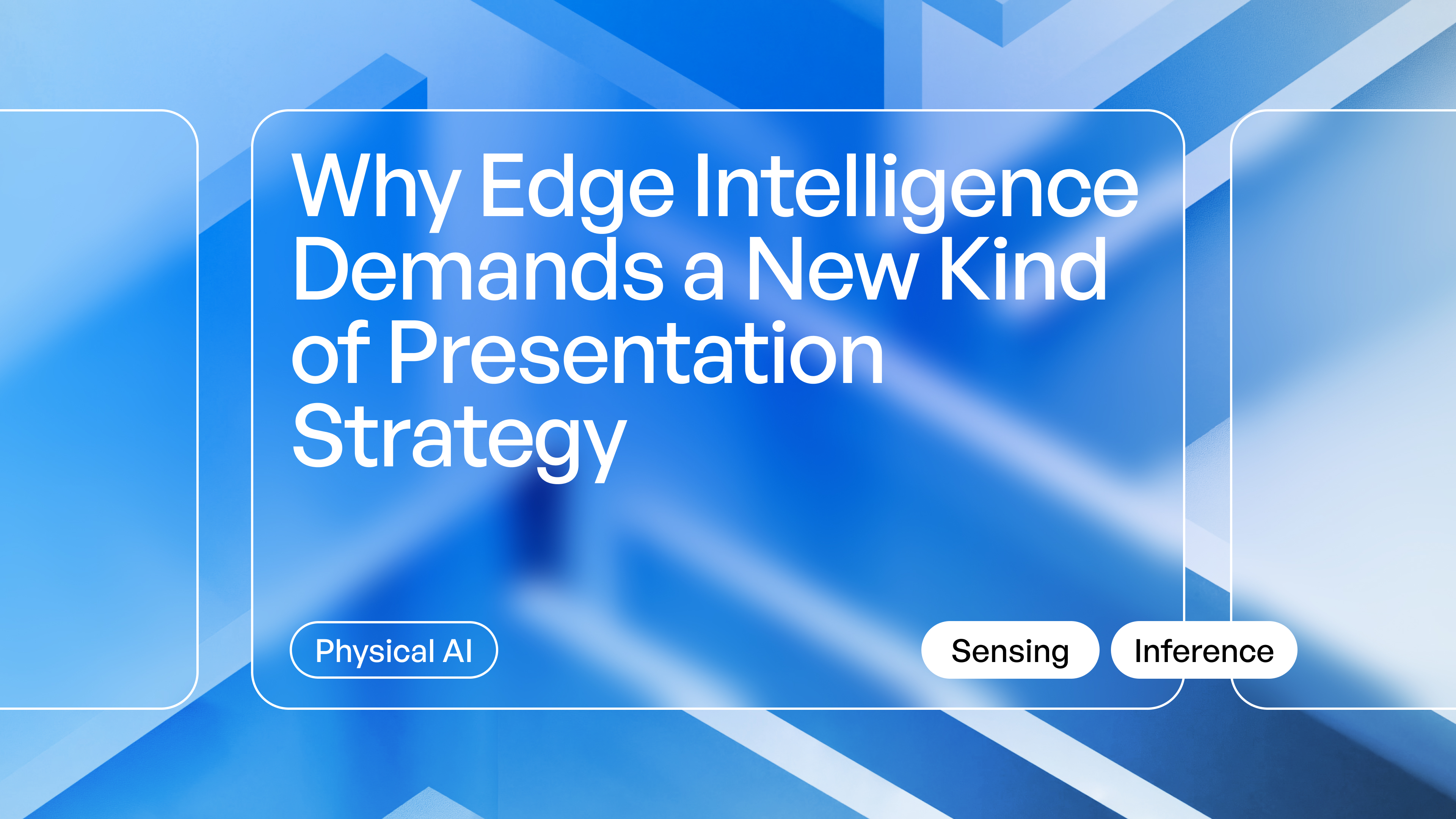Physical AI Is Here

We’re entering the next phase of artificial intelligence — one where intelligence moves from the cloud into the real world.
From autonomous forklifts in logistics centers to AI-enabled surgical robotics, and from agriculture drones to industrial automation arms, a new wave of systems is emerging. These are not cloud-dependent applications. They need to see, sense, decide, and act — in real time, with limited power, in uncontrolled environments.
This is Physical AI.
Physical AI refers to embedding intelligence into physical systems such as robots, drones, vehicles, or sensors. Unlike traditional cloud AI, these systems operate at the edge, where constraints around power, bandwidth, latency, and reliability are real. These machines sense the world around them, run inference on-device, and control mechanical systems with no room for lag or ambiguity.
Yet for many of these companies, the real challenge isn’t engineering. It’s communication.
How do you explain complex perception pipelines, hardware constraints, inference loops, and safety logic to an investor in 10 minutes or less? How do you show system architecture without alienating non-technical stakeholders?
In this post, we’ll look at how Physical AI is reshaping not just technology — but the storytelling frameworks we need to explain, defend, and fund it.
1. Why AI is moving to the edge
From centralized compute to embedded intelligence
For most of the last decade, AI lived in the cloud. Large data centers, massive GPU clusters, and globally-distributed training pipelines defined the first wave of AI investment. It worked well for ad targeting, generative models, and backend analytics.
But in robotics, mobility, and edge sensing, that model breaks down.
When latency, power, and bandwidth are constrained, inference needs to happen locally. You can’t stream 4K video from a drone to the cloud and wait for a classification. The compute must live onboard.
This shift is no longer niche. In 2024, over half of embedded AI deployments were edge-based (Mordor Intelligence). The edge AI market in robotics alone is expected to grow nearly 19% CAGR, driven by logistics, agriculture, and surveillance use cases (HTF Market Report).
Companies like NVIDIA are responding. With its Jetson product line — and more recently Jetson Thor — NVIDIA is pushing inference to the edge, embedding high-performance AI modules directly into physical systems like robots and industrial arms. As CEO Jensen Huang said in a recent launch:
“The future of AI is physical. Intelligence that can sense, decide, and act in the world — that's the next industrial revolution.”
It’s not just NVIDIA. Google’s Coral platform, AMD’s Versal AI Edge chips, and companies like SiMa.ai and Axelera AI are all designing silicon specifically for edge inference.
The challenge for startups in this space is explaining how their stack works and why it’s unique.
2. The two foundations of Physical AI: Sensing and inference
A. Sensing: Seeing the world, precisely
Physical AI systems rely on a wide array of sensors — LiDAR, radar, RGB cameras, thermal, ultrasonic, inertial measurement units (IMUs), and more. But it’s not just about collecting data. The system must:
- Filter, denoise, and calibrate inputs
- Align and fuse different modalities
- Deal with degraded or partial data in real time
- Operate within bandwidth and compute limits
This is perception engineering, and it’s often underappreciated outside of technical circles.
Technologies like event cameras, foveated vision, and even physics-inspired algorithms like those in PhyCV (a lightweight computer vision library) are helping teams reduce data loads while improving scene understanding.
B. Inference: Deciding and acting, instantly
After sensing, systems must run inference — determining what action to take based on context. At the edge, this means models must be:
- Compressed and quantized for tiny memory footprints
- Fast and predictable under real-time constraints
- Robust to noise, edge cases, and environmental variation
- Auditable for safety and compliance
In high-stakes environments like automotive or industrial robotics, inference can't fail silently. These systems often incorporate redundancy, fallback logic, or hybrid inference modes where some computation is offloaded to a near-edge server.
As DeepMind’s Oriol Vinyals put it:
“Inference in the real world isn’t just about accuracy. It’s about robustness, latency, and accountability — all at once.”
3. Why Physical AI needs a new kind of pitch deck
For enterprise software or SaaS products, pitch decks follow familiar patterns: feature overviews, traction charts, product mockups, TAM slides.
For Physical AI companies, that approach falls apart. You’re not selling features. You’re selling system-level performance under constraints — and the margin for error is tiny.
Here’s what your presentation strategy must account for:
1. Complex technical diagrams
- Sensor configurations in physical space
- Data flow from signal to model to actuator
- Timing diagrams and latency budgets
- Redundancy and fallback logic
To avoid overwhelming your audience:
- Introduce the system in layers (e.g. sensors → data path → model)
- Use consistent visual language for sensors, compute, data
- Animate selectively to highlight signal flow and control loops
2. Visual language that balances engineering and branding
Your visuals must walk a fine line — credible to engineers, inspiring to investors. That means:
- Custom icons for perception modules, edge compute, control systems
- Elegant use of typography, grid systems, and spatial logic
- A design system that can scale from slide to white paper to demo interface
3. Performance metrics in context
It’s not enough to say “12 ms latency” or “92% accuracy.”
Visualize those metrics in the context of the system:
- A latency budget timeline with your model highlighted
- Accuracy drop-off under occlusion or sensor noise
- Throughput vs. power tradeoffs across environments
4. Investor-ready narratives that preempt doubt
In this space, skepticism is high. Investors want to know:
- How do you handle sensor failure?
- What’s your compute fallback plan?
- Can this scale to other form factors?
Your deck must proactively address these. Include:
- Failover diagrams
- Edge/cloud hybrid strategies
- Compliance and safety visual cues
Conclusion: The Physical World Doesn’t Wait
The shift toward Physical AI is real and accelerating.
If you’re building robotics platforms, edge inference modules, or embedded AI stacks, you’re not just solving technical problems. You’re competing in a storytelling arms race where the complexity of your system must be simplified without distortion and explained without dilution.
At Prznt Perfect, we work with deep-tech companies to translate layered, multidisciplinary systems into compelling visual stories that secure funding, partnerships, and market trust.
We don’t just design slides — we architect communication systems as sophisticated as the technology they support.
If you're building something that sees, thinks, and acts in the physical world, we’d love to help you make it intelligible and irresistible — let’s talk.
Keep reading
→ Designing Presentations for Experts
→ Creating a Visual Language That Scales with Your Business
→ Inside Our Process: How We Work With Your Team

- This is some text inside of a div block.lay out the facts clearly and compellingly. Use data to establish the ground reality, but remember that facts alone are like the individual strands of a tapestry—necessary but not complete.lay out the facts clearly and compellingly. Use data to establish the ground reality, but remember that facts alone are like the individual strands of a tapestry—necessary but not complete.
- This is some text inside of a div block.lay out the facts clearly and compellingly. Use data to establish the ground reality, but remember that facts alone are like the individual strands of a tapestry—necessary but not complete.




